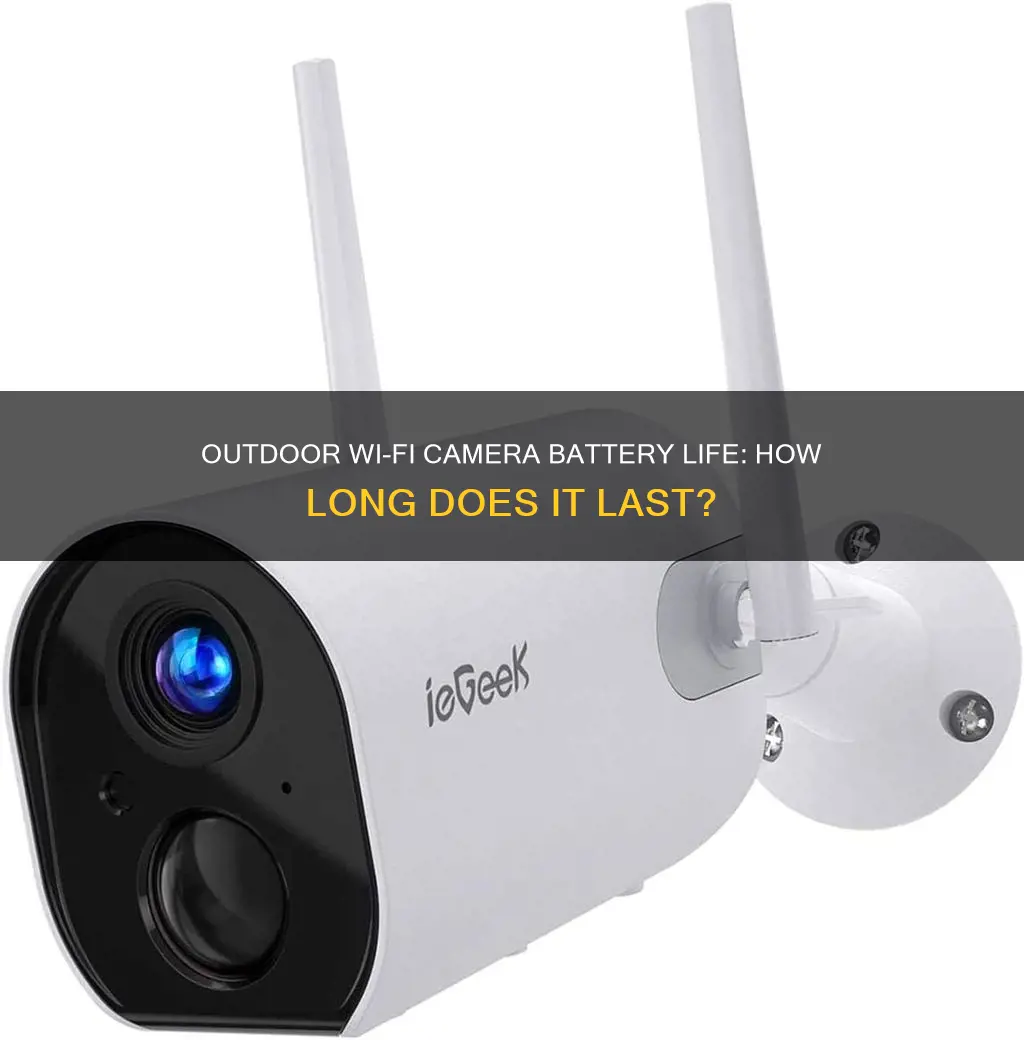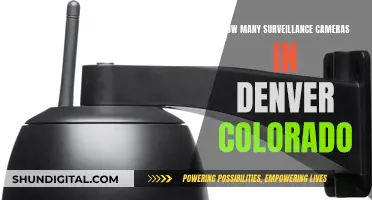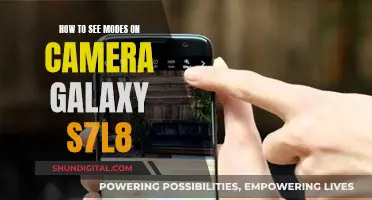
The longevity of a battery in an outdoor Wi-Fi camera depends on several factors, including usage, battery capacity, settings, temperature, and firmware. On average, a battery in an outdoor Wi-Fi camera can last anywhere from three to twelve months. However, in high-traffic areas or areas with frequent motion, the battery may need to be recharged every few months. Additionally, cold weather can significantly impact battery performance, with frigid temperatures reducing battery capacity and lifespan. To maximise battery life, it is recommended to ensure optimal signal strength, limit live view usage, and consider weather-resistant options and motion detection settings.
| Characteristics | Values |
|---|---|
| Average Battery Life | 3-6 months |
| Longest Battery Life | 2 years |
| Factors Affecting Battery Life | Camera usage, battery capacity, security camera settings, temperature, firmware, signal strength, live view duration, cold weather, motion detection events |
| Power-Saving Measures | Motion-activated cameras, solar-powered cameras, energy-saving features, optimal camera location, backup battery |
What You'll Learn

The impact of cold weather on lithium batteries
Lithium batteries are highly popular due to their high energy capacity, allowing for smaller and lighter batteries. They are also rechargeable and have longer lifespans than other batteries. However, they are affected by cold weather.
Cold temperatures slow down the chemical reactions that take place inside lithium batteries, hampering their performance and reducing their discharge capacity. The maximum amount of energy that the battery gives off will drop in lower temperatures. This is true of all batteries. Below-freezing temperatures can temporarily reduce the capacity of a lithium-ion battery. When a battery's internal temperature drops below 32°F (0°C), the lithium cells cannot accept the same amount of charging current (warmth) as they do at warmer temperatures.
Lithium batteries cannot be charged at freezing temperatures. Attempting to charge a lithium battery below 32°F (0°C) can cause lithium plating, which lowers the battery's capacity and can cause short circuits, damaging it irreparably. Therefore, it is important to never charge a lithium battery when the temperature is below freezing.
To charge a lithium battery in freezing conditions, you must first raise its temperature. This can be done by moving the battery to a warmer environment, wrapping it in a thermal blanket, or placing it near a heater.
In summary, while lithium batteries are highly effective and popular, they are susceptible to cold temperatures, which can reduce their performance and require more frequent charging. To ensure optimal performance and longevity, it is important to store and use lithium batteries in suitable temperature conditions, and to avoid charging them in freezing temperatures.
Camera Batteries: Do They Die?
You may want to see also

How to extend security camera battery life
The battery life of outdoor WiFi cameras varies, lasting anywhere from a few weeks to six months on a single charge, depending on usage, temperature, settings, and other factors. To extend the battery life of your outdoor WiFi camera, consider the following:
Choose the right camera:
- Opt for a camera with a swappable battery so you can minimise downtime by charging a spare battery while using the other.
- Ensure your camera has motion-sensing capabilities as continuous recording will deplete the battery very quickly.
- Check manufacturer estimates for battery life, bearing in mind that these are usually optimistic.
Choose the right settings:
- Set the camera to a schedule so that it doesn't record at times when you're home and awake.
- Set the camera to activate when it detects a human shape rather than general motion detection, to avoid unnecessary triggers.
- Exclude high-traffic areas such as public streets from your detection settings.
- If your camera has built-in spotlights, opt for night-vision instead to conserve battery.
Choose the right location:
- Avoid mounting your camera in busy areas such as hallways or streets, as this will trigger recording more frequently.
- Place the camera in an area with good WiFi connectivity to avoid a weak signal draining the battery.
- Keep the camera in temperate conditions to avoid abnormal battery status indications.
Additional accessories:
- Solar panels are a cost-effective way to extend the life of your camera, charging it during the day for use at night.
- Extended battery housings, such as those offered by Arlo, add bulk but significantly increase battery life.
- External battery packs or power adapters can be used, but you will lose the wireless capability.
Other tips:
- Use rechargeable batteries to save money and avoid frequent replacements.
- Use a battery-powered camera with PIR motion sensors to distinguish human and animal movement, reducing false alarms.
- Adjust the motion sensor sensitivity to reduce false alerts and unnecessary recordings.
- Schedule motion detection times to reduce battery usage when you don't need the camera to be active.
- Place the camera in an area with less traffic to avoid unwanted motion notifications.
- Ensure your camera is running on the latest firmware to avoid glitches and loopholes that impact performance.
- Integrate other surveillance cameras or systems to cover all areas of interest and extend battery life.
Cleaning Camera Battery Acid: Step-by-Step Guide
You may want to see also

Power-saving measures
The battery life of outdoor Wi-Fi cameras varies depending on the model, usage, and other factors. Some batteries can last up to 12 months, while others may need to be charged every two to three months. Here are some power-saving measures to help extend the battery life of your outdoor Wi-Fi camera:
- Use motion-activated cameras: Motion-activated cameras only turn on the recording feature when they detect motion, which can help conserve battery life. These cameras can also connect wirelessly through the cell network and send alerts or footage to your phone or a security team.
- Supplement with solar power: Solar panels can be used to supplement the power source of your outdoor Wi-Fi camera. Solar-powered cameras use the sun's energy to keep the camera running, even on cloudy days. The extra power is stored in the battery, extending the life of the unit.
- Choose the right location: Ensure that your camera is not pointlessly observing high-traffic areas like sidewalks and busy roads. Reposition the camera so that it is closer to the wireless router to ease connectivity issues and improve battery efficiency.
- Turn on energy-saving features: Check the user guide and control app for your camera to see if there are any energy-saving features you can enable. This may include reducing the camera's motion detection sensitivity, using 'people-only' detection, or setting up predefined zones.
- Consider a solar panel: Solar panels provide a cost-effective solution for powering electrical devices, including wireless security cameras. Connect a compatible solar panel to your camera to charge the battery using sunlight.
- Have a backup battery: Although this won't improve battery life, it will ensure that your camera can run continuously. Simply swap out the drained battery for a fully charged backup battery.
Using Camera and Wi-Fi: How Much Battery Drain?
You may want to see also

Solar-powered cameras
Solar panels can be purchased separately or bundled with specific camera models. For example, Ring offers its Stick Up Cam with a solar panel for $140, while the Arlo Pro 4 camera, which is pricier than some competitors, requires a separate purchase of their solar panel.
When choosing a solar-powered camera, consider the following:
- Security: Wireless cameras are more susceptible to hacking due to their Wi-Fi connectivity.
- Video Quality: Higher resolutions provide better footage, but also require more bandwidth, which may result in lag or glitches.
- Storage: Cloud storage typically requires a monthly fee, whereas local storage relies on accessories like microSD cards.
- Region: Solar panels are most effective when angled towards the equator, so their efficiency decreases in regions farther from the equator or during seasons with less sunlight.
To maximise the lifespan of your solar-powered camera, ensure it receives direct sunlight for at least six hours daily, preferably in a south-facing spot. Additionally, consider factors such as motion detection, video resolution, and frame rate, as adjusting these settings can help conserve battery power.
Some popular options for solar-powered cameras include:
- Reolink Argus 3 Pro: Offers excellent video quality, customisation options, and a healthy 3.2-watt solar panel.
- EufyCam 3: The only camera on the list with built-in solar panels, making installation easier. It also boasts 4K video quality and impressive local storage.
- Arlo Pro 3 Floodlight: Compatible with Arlo's solar panel, this camera provides excellent cloud storage and a wide range of camera options.
- Ring Stick Up Cam Solar: Ring offers a diverse selection of solar panels for its cameras and video doorbells, including the Super Solar Panel, which supplies up to 5 watts of power.
- Wyze Cam Battery Pro: Features a 2K video resolution, night vision, and a removable battery. The Wyze Solar Panel is a must-have addition to improve battery life.
Charging HD IR Camera Watches: A Step-by-Step Guide
You may want to see also

Motion-activated cameras
When it comes to battery life, motion-activated cameras offer some advantages. By only recording when triggered, they consume less power, resulting in longer battery life. The exact duration will depend on various factors, including usage patterns, battery capacity, and camera settings.
- Opt for motion-activated cameras with PIR (Passive Infrared) sensors. PIR sensors detect changes in infrared energy levels when a warm body, such as a person or animal, passes by. This technology ensures the camera only activates when necessary, preserving battery life.
- Consider the placement of your motion-activated cameras. Ensure they are installed in a direction that maximises the sensitivity of the motion detection. For PIR sensors, positioning the camera to detect motion across its field of view, rather than directly facing it, will enhance sensitivity.
- Utilise scheduling and customisation features. Many motion-activated cameras allow you to schedule motion detection for specific periods, reducing false alarms and conserving battery. You can also define specific motion detection areas to target certain places, minimising unnecessary recordings.
- Choose cameras with energy-saving features. Some cameras offer energy-saving modes or customisable settings that can help extend battery life. For example, reducing the motion detection sensitivity or enabling "people-only" detection can conserve power.
- Consider solar-powered options. If your camera is placed in an area inaccessible to a power source, solar-powered cameras or those supplemented with solar panels can be a great solution. This not only extends battery life but also provides an eco-friendly alternative.
- Reolink Argus 4 Pro: This wire-free camera offers a wide field of view, colour night vision, and up to 30% more battery life than similar models. It is also dual-band Wi-Fi compatible and features smart detection capabilities.
- Reolink Argus PT: A compact and versatile camera that works both indoors and outdoors. It features a smart PIR motion sensor, capturing video and audio within a second of detection. Its rechargeable battery and solar power option provide added convenience.
- Reolink RLC-810A: An affordable outdoor camera with 4K UHD resolution and audio recording. It has a small, discreet form factor and offers smart person and vehicle detection.
- Ring Stick Up Cam: This versatile camera can be plugged in, powered by a battery, or charged by a solar panel. It offers crisp 1080p video, clear two-way audio, and accurate motion detection.
- Arlo Pro 4 Spotlight Camera: A battery-powered camera that captures clear 2K video. While it requires a subscription for video storage, it offers advanced features like colour night vision and Auto Zoom and Tracking.
In summary, motion-activated cameras are a great choice for outdoor surveillance, offering efficient recording and extended battery life. By considering the camera's features, placement, and settings, you can further maximise battery life and ensure reliable monitoring.
Xomodo Wireless Cameras: How Long Does the Charge Last?
You may want to see also
Frequently asked questions
This depends on several factors, including usage, battery type, temperature, and features. On average, a battery in an outdoor Wi-Fi camera can last between three and six months. However, in high-traffic areas, the battery may need to be recharged every two to three months.
The battery life of an outdoor Wi-Fi camera is influenced by various factors, including signal strength, live view duration, temperature, and the number of motion detection events. Poor signal strength and frequent live viewing can drain the battery faster. Cold temperatures can also significantly impact battery performance, especially in lithium-ion batteries. Additionally, cameras with features like night vision or continuous recording may consume more power and require more frequent charging.
Yes, there are a few ways to extend the battery life:
- Use motion-activated cameras: Motion-activated cameras only record when motion is detected, saving power.
- Optimise camera placement: Ensure the camera is within a reasonable range of the base station and minimise obstructions that can interfere with the signal.
- Adjust motion detection settings: Fine-tune the sensitivity, recording time, and detection zone area to reduce power consumption.
- Consider solar power: Solar-powered cameras can extend battery life by recharging the battery using solar energy.
Yes, an alternative to battery-powered cameras is to use wired cameras that are plugged into a power source. While they may require more effort to install, wired cameras eliminate the need for frequent battery changes or recharging. Additionally, some cameras use solar panels to recharge the battery, reducing the need for manual recharging.







